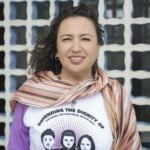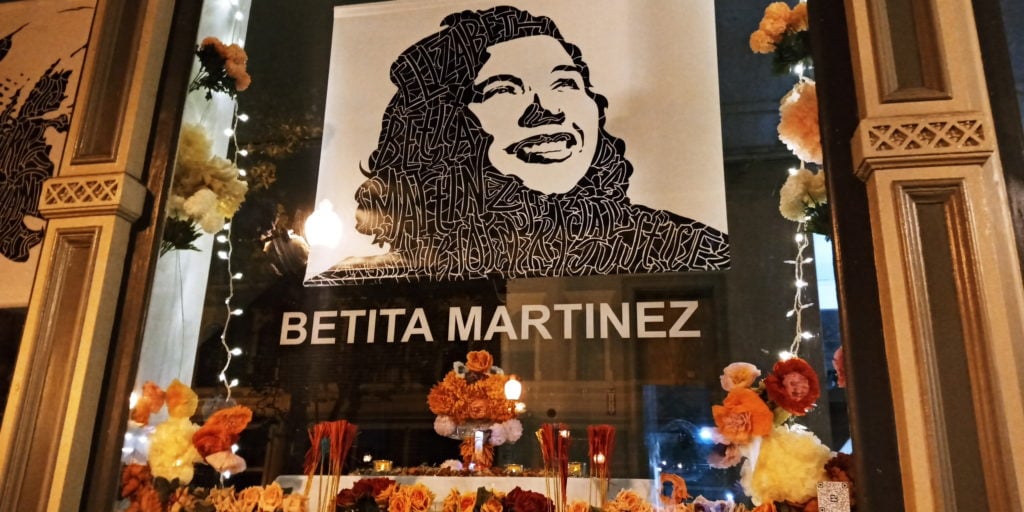With deep sadness and respect, Organizing Upgrade will be sharing a few tributes to movement elder Betita Martinez, who died June 29. In her 95 years she lived many lifetimes, and brought her commitment, wit and political clarity to several of the most significant social movements of our day.
Elizabeth “Betita” Sutherland Martinez grew up in the suburbs of Washington, D.C. After college she moved to New York City, where she worked for the United Nations and then immersed herself in the literary scene as an editor and writer. In 1965, when she was 40, she became the director of SNCC’s New York office, plunging into the full-time activism that would define the rest of her life.
When SNCC turned towards all-Black leadership in 1967, Betita first explored radical feminism, then a largely white space. A year later she moved to New Mexico to learn about the land rights struggle led by Reies Lopez Tijerina. There she co-founded the newspaper El Grito del Norte (Cry of the North) and the Chicano Communications Center, a Marxist collective. When the collective fell apart in 1974, Betita moved to San Francisco and worked for 10 years with the Democratic Workers Party. After the party dissolved, she continued her work as an organizer, writer, and teacher. She founded the Institute for MultiRacial Justice, helped launch the publications CrossRoads and War Times, taught and lectured and published more than 100 articles. Among her several books, 500 Years of Chicano History in Pictures and 500 Years of Chicana Women’s History are probably the best known.
In “The Work Said Who I Was,” Betita’s longtime comrade Tony Platt offers an eloquent capsule biography, which we drew on for this introduction. Our first reflections come from Cindy Wiesner and Amy Sonnie.
Gracias, Betita, por todo
“Betita was a trailblazer and theoretician, she embodied inter-generational bridge-building,”
Betita taught me, Betita taught all of us! Betita will continue teaching many more!
Betita Martinez, Presente!!! Betita was a mentor, friend, comrade/ co-madre, I was lucky to serve on the Women of Color Resource Center Board with her, and participate in the Institute for MultiRacial Justice which she helped found. She taught many of us Marxism and the importance of radical women of color feminism. Even though I am Salvadoran and Colombian, she included me in 500 Years of Chicana Women’s History. We spent many afternoons in her backyard talking politics or chisme, with her beloved dog Xochitl at our feet.
Betita was a tour de force, prolific writer, and movement documentarian. She was always the best dressed elder, with her shiny, sexy outfits, perfectly coiffed black hair, and signature red lips. She held people accountable with her wit, had a loud laugh, and was never afraid to tell the hard truths. She was humble, and lived within her means as most people who are committed revolutionaries do – but she was also generous, always contributing funds to young people of color going on international delegations like Cuba or Mexico.
Betita was a trailblazer and theoretician, one of the first Chicanas in the Student Nonviolent Coordinating Committee, and in early, mostly white, radical feminist spaces. She ran for governor of California, and helped build revolutionary organizations. A tireless advocate for building an alternative economic and political system, she stressed the importance of radical ideology and formation. She started newspapers and wrote timely and evergreen articles that shaped a whole generation of activists. She embodied inter-generational bridge-building, was a big practitioner and advocate of multi-racial organizing, and a true diehard internationalist. There is so much more to say about Betita and all her accomplishments, a multitude of accolades and flowers we need to give her. We, I, honor her life, by saying “Gracias, Betita, por todo.” So many of us are forever shaped by her, and – I hope – many more are inspired by all her work and legacy! #BetitaTaughtMe #BetitaTaughtUs
 Cindy Wiesner is a 30-year veteran of the social justice movement in the U.S. and internationally. She is the executive director of the Grassroots Global Justice Alliance (GGJ) and Grassroots Global Justice Action Fund (GGJAF). She helped co-found the Climate Justice Alliance and has been active in many movement-building initiatives, including The Frontline, It Takes Roots, the Rising Majority, and the Green New Deal Network.
Cindy Wiesner is a 30-year veteran of the social justice movement in the U.S. and internationally. She is the executive director of the Grassroots Global Justice Alliance (GGJ) and Grassroots Global Justice Action Fund (GGJAF). She helped co-found the Climate Justice Alliance and has been active in many movement-building initiatives, including The Frontline, It Takes Roots, the Rising Majority, and the Green New Deal Network.
#BetitaTaughtMe: Building and Bridging
By Amy Sonnie
Rest in Power Betita Martinez. Like thousands of others, I am saddened to hear of Betita’s passing. In her honor, I want to share a story of her legacy that is profoundly relevant to today’s movements. This is a story of building and bridging, calling in, and holding contradictions to build lasting intergenerational, multiracial movements.
#BetitaTaughtMe because she called me in long before “call out culture” or “calling in” existed in the Left lexicon. Betita called my generation into principled debate because that is what movement building requires. Betita showed me that we are not opponents when we disagree. We can be treasured even when we make mistakes. We can come together instead of apart when we face generational divides. And, most importantly, that the movement needs every single one of us.
The meaning of movement
In 1998-2001, I participated in the Challenging White Supremacy (CWS) Workshop, then a joint program of the Institute for MultiRacial Justice (led by Betita and Phil Hutchings) alongside Sharon Martinas, who became one of my lifelong mentors, and Mickey Ellinger. In 1999, several young leaders in CWS raised concerns about the curriculum, pushing for workshops that addressed racism’s intersections with class, gender, and sexuality more explicitly.
At the time, CWS focused on racism solely and deliberately—asking its white participants to acknowledge the detours white people take to deflect attention from racism or make false equivalencies (“I’m oppressed as a queer woman, so I understand racism”). We understood the truth of these detours, but most of the younger leaders in CWS came of age in activist projects shaped by the concept of intersectionality. We escalated demands for a change.
Betita stepped in. The problem, she said, was not our political assessment, it was our approach: we had staged a mini-rebellion within CWS, a blockade—rather than extending a genuine invitation to dialogue about how and why CWS might expand its praxis to reflect interlocking systems of oppression. We did not intend to show disrespect to Sharon, who had developed much of the CWS pedagogy. But we did.
In presenting our critiques, many of us failed to learn about the deep political traditions that informed the existing program. We also underestimated Sharon’s genuine interest in learning from us. Upon reflection, I think we were more focused on opposing authority and the correctness of our critiques. We showed little curiosity about her story, her work, and her kinship with a broad network stretching back to SNCC and early civil rights work. She had seen principled conflict, and she had seen movements destroyed by the absence of it.
Betita called us to the mat. She literally sat us down—on a rug in an old Victorian in San Francisco’s Mission District—and facilitated space for us to learn the lessons of movements torn apart by acrimony, internal conflict, and factionalizing. She asked us to put ourselves in the shoes of the lifelong organizers we treated like they were “out of touch.” She showed us our impact (truthfully: our divisiveness) and then, she invited us to consider a different way, a path to co-create. She never shamed us for self-righteousness or passion. Instead, she invited us to channel that passion in a more principled way, and to ask as many questions as we purported to answer.
I will never forget the olive green velvet of the couch she sat on. The dark mahogany wainscoting of the room. The circle of people gathered on the carpet learning to hold contradictions and disagreements—with love. I can recall every color and texture in that room now (21 years later) because it was a moment of deep personal and political revelation for me. An indelible moment.
When is the last time you felt so transformed? When have you felt valued for your insights and simultaneously asked to bring more than just criticism? To build up instead of take down? To experience true community—both heard and called to hear others?
Betita showed me how to move with purpose and humility, urgency and patience. She and Sharon both modeled what it means to be part of a movement—not a racism workshop or a nonprofit organization. A movement, with a history, a present, and a future we must choose to steward and interrogate.
Changing the course
As a result of this meeting, Sharon devised a yearlong study of race, class, gender, and other tendencies within antiracist traditions. We studied labor movements, anarchism, patriarchy and Black feminism, and poor white people’s participation in movements for justice. I prepared our session on class-based organizing of poor white people in alliance with civil rights and Black Power. Ten years later, James Tracy and I published a book based on this research, and next month we’ll release an updated 10-year anniversary edition and study guide.
CWS took a brief hiatus and embarked on a redesign with sessions on patriarchy and class within the context of racialized capitalism. During this time CWS also began incubating the Catalyst Project, and in 2004 Catalyst formally took the reins, soon thereafter launching the Anne Braden Anti-Racist Training Program. The intergenerational learning and principled debate we engaged in nurtured this evolution, and pushed the work even further—especially around trans inclusion and disability justice.
None of this would have been possible without Betita and Sharon. If it weren’t for the movement-building approach that Betita modeled, my generation of young activists might have succeeded in tearing something down rather than building it up. It wasn’t our intent, but the choice we failed to see, at first, is that disruption can be either productive or destructive.
#BetitaTaughtMe
#SharonTaughtMe
What would Betita do?
Today, as a new generation of movement leaders grapple with the tensions, power, political alignment (and misalignment) inherent in any intergenerational movement for change, we have similar choices to make. As adrienne maree brown recently wrote, “We won’t get free if we can’t learn to operate at the scale of collaboration across differences, across platforms and exposure, in spite of efforts to sow dissent amongst us, to develop leaders who know how to disagree and still work together.”
We cannot atomize, avoid conflict, ignore attacks or—worse—feed into them.
Let’s look to Betita for guidance. What can we build and how can we bridge? What lessons can we learn from history? What would Betita do? Where can we co-create space for principled political struggle?
 Over the past two decades I’ve come back to this experience and I’ve continued to see its profound lesson: it’s in that struggle that we find true belonging. I am grateful.
Over the past two decades I’ve come back to this experience and I’ve continued to see its profound lesson: it’s in that struggle that we find true belonging. I am grateful.
Amy Sonnie is an activist, writer, and librarian. She is author of two books on U.S. social justice movements, including Hillbilly Nationalists, Urban Race Rebels, and Black Power, and co-founder of the Center for Media Justice with Malkia Cyril and Jen Soriano.
Did you enjoy this article?
We're in the middle of our annual fund drive, and this year we're building our own internal infrastructure for subscriptions, meaning more of every dollar pledged goes to fulfilling our mission. Subscribe today to support our work and be a part of Convergence's next evolution.
